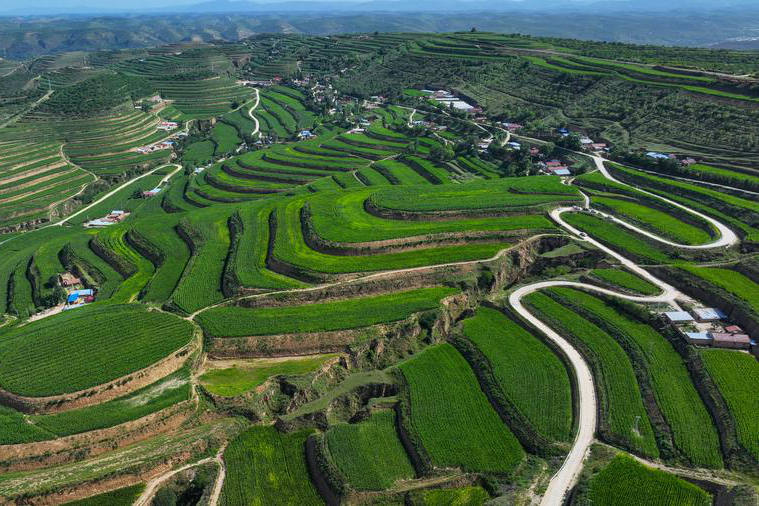
 0 Comment(s)
0 Comment(s) Print
Print E-mail China.org.cn, December 10, 2024
E-mail China.org.cn, December 10, 2024

An aerial drone photo taken on July 25, 2024 shows rural roads connecting fields and villages in Pengyang county, Guyuan city, northwest China's Ningxia Hui autonomous region. [Photo/Xinhua]
China has made remarkable strides in rural road development, according to a white paper recently issued by the State Council Information Office. Titled "China's Rural Roads in the New Era," the white paper outlines the nation's achievements and vision for rural road development and shares China's experience.
According to the white paper, upgraded and newly built rural roads added more than 2.5 million kilometers over the past decade. By the end of 2023, the total length of rural roads reached 4.6 million kilometers, equivalent to circling the equator 115 times – a 21.7% expansion compared to 2013. The network includes 700,000 kilometers of county roads, 1.24 million kilometers of township roads and 2.66 million kilometers of village roads. This extensive infrastructure network connects rural and urban areas through county roads, while township roads crisscross regions and village roads link households and farmland.
Rural roads serve as the primary, and often only, transport channel in China's rural communities, playing a critical role in the nation's development. As the Chinese saying goes: "If you want to be wealthy, build roads first." Guided by this understanding, the Chinese government – committed to improving rural living standards – has spared no effort in financing rural road development.
Over the past decade, the government has invested 4.3 trillion yuan ($590 billion) in fixed assets and 1.1 trillion yuan in maintenance. Through diverse market-based financing mechanisms, the country provides approximately 80% of the total funding, expediting the development of high-quality rural roads.
Since the 18th CPC National Congress in 2012, China's rural road development has entered a new phase. The initiative combines institutional innovation, pertinent policies, systematic planning and targeted implementation to achieve high-quality development. These upgraded and newly built rural roads support comprehensive rural development, helping advance rural revitalization and rural modernization.
In line with a people-centered development philosophy, China has integrated rural road development with national strategies for poverty eradication, agriculture modernization and rural modernization. Key policies include the Plan for Rural Roads Construction (2005), the Outline of Poverty Alleviation-Oriented Transport Projects in Contiguous Poverty-Stricken Areas (2011-2020) and the Outline for National Territorial Space Planning (2021-2035). The resulting road network connects industrial parks and tourist destinations, boosting cultural tourism and local businesses. This enhanced rural-urban integration over the past decade has driven rural production and consumption, improving rural household income.
According to the National Bureau of Statistics, rural residents' per capita disposable income grew faster than their urban counterparts in 2023. Rural disposable income reached 21,691 yuan, up 7.7% in nominal terms and 7.6% in real terms. Over the past 10 years, rural household income has grown steadily from 9,430 yuan in 2013 to 20,133 yuan in 2022, supported by strategies linking poverty alleviation, agricultural modernization and rural revitalization with road development.
To strengthen rural logistics and boost urban-rural integration, local authorities have created extensive rural passenger transport networks. These systems use county seats as hubs, towns and townships as nodes, and administrative villages as terminuses, providing vital connections between urban and rural areas.
Over the past decade, more than 1,100 towns and townships and 45,000 villages have gained access to transportation networks, bringing bus services to all these communities. The coordinated development of urban-rural logistics has fostered a vibrant two-way flow of goods and services. This connectivity has helped to unlock the potential of rural industries, such as tourism, and empower rural areas to embrace e-commerce and express delivery services – accelerating agricultural modernization and rural revitalization.
Through its unique approach to rural road development, China has effectively addressed transport bottlenecks that previously impeded economic growth and people's incomes. In this process, the country's experience offers valuable insights and solutions for global poverty reduction.
Alexander Ayertey Odonkor is a global economist with keen interest in the social, environmental and economic landscape of developed countries, emerging markets and developing economies particularly in Asia-Pacific, Africa, Europe and North America.
Opinion articles reflect the views of their authors, not necessarily those of China.org.cn.